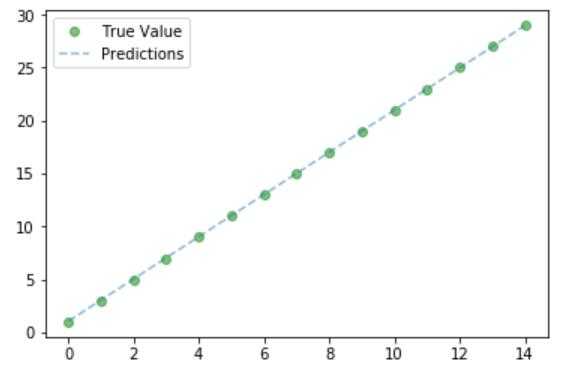标签:输入输出 com jpg value lin forward 观察 方法 lib
假定我们要拟合的线性方程是:\(y=2x+1\)
\(x\):[0, 1, 2, 3, 4, 5, 6, 7, 8, 9, 10, 11, 12, 13, 14]
\(y\):[1, 3, 5, 7, 9, 11, 13, 15, 17, 19, 21, 23, 25, 27, 29]
import torch
import torch.nn as nn
from torch.autograd import Variable
import numpy as np
import matplotlib.pyplot as plt
'''生成输入输出'''
x_values = [i for i in range(15)]
x_train = np.array(x_values, dtype=np.float32)
x_train = x_train.reshape(-1,1)
y_values = [2*i+1 for i in x_values]
y_train = np.array(y_values, dtype=np.float32)
y_train = y_train.reshape(-1,1)
'''定义模型'''
class LinearRegressionModel(nn.Module):
def __init__(self, input_dim, output_dim):
super(LinearRegressionModel,self).__init__() #用nn.Module的init方法
self.linear = nn.Linear(input_dim, output_dim) #因为我们假设的函数是线性函数
def forward(self, x):
out = self.linear(x)
return out
''''''
input_dim = 1
output_dim = 1
model = LinearRegressionModel(input_dim, output_dim)
criterion = nn.MSELoss() #损失函数为均方差
learning_rate = 0.01
optimizer = torch.optim.SGD(model.parameters(), lr=learning_rate)
'''训练网络'''
epochs = 30
for epoch in range(epochs):
epoch += 1
inputs = Variable(torch.from_numpy(x_train))
labels = Variable(torch.from_numpy(y_train))
#清空梯度参数
optimizer.zero_grad()
#获得输出
outputs = model(inputs)
#计算损失
loss = criterion(outputs, labels)
#反向传播
loss.backward()
#更新参数
optimizer.step()
print('epoch {}, loss {}'.format(epoch, loss.data[0]))输出如下
epoch 1, loss 290.4517517089844
epoch 2, loss 39.308494567871094
epoch 3, loss 5.320824146270752
epoch 4, loss 0.721196711063385
epoch 5, loss 0.09870971739292145
epoch 6, loss 0.01445594523102045
epoch 7, loss 0.003041634801775217
epoch 8, loss 0.0014851536834612489
epoch 9, loss 0.0012628223048523068
epoch 10, loss 0.0012211636640131474
epoch 11, loss 0.0012040861183777452
epoch 12, loss 0.0011904657585546374
epoch 13, loss 0.001177445170469582
epoch 14, loss 0.0011646103812381625
epoch 15, loss 0.0011519324034452438
epoch 16, loss 0.0011393941240385175
epoch 17, loss 0.0011269855313003063
epoch 18, loss 0.0011147174518555403
epoch 19, loss 0.001102585345506668
epoch 20, loss 0.001090570935048163
epoch 21, loss 0.0010787042556330562
epoch 22, loss 0.0010669684270396829
epoch 23, loss 0.0010553498286753893
epoch 24, loss 0.001043855445459485
epoch 25, loss 0.0010324924951419234
epoch 26, loss 0.0010212488705292344
epoch 27, loss 0.0010101287625730038
epoch 28, loss 0.000999127165414393
epoch 29, loss 0.0009882354643195868
epoch 30, loss 0.0009774940554052591
#可以看出loss逐步缩小画图观察
predicted = model(Variable(torch.from_numpy(x_train))).data.numpy()
plt.clf()
plt.plot(x_train, y_train, 'go', label="True Value", alpha=0.5)
plt.plot(x_train, predicted, '--', label='Predictions',alpha=0.5)
plt.legend(loc='best')
plt.show()图如下:

标签:输入输出 com jpg value lin forward 观察 方法 lib
原文地址:https://www.cnblogs.com/MartinLwx/p/10353706.html